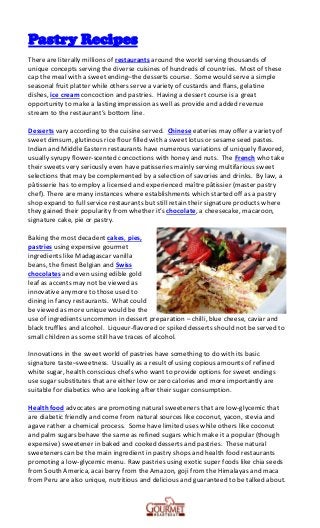
Pastry Recipes
- 1. Pastry Recipes There are literally millions of restaurants around the world serving thousands of unique concepts serving the diverse cuisines of hundreds of countries. Most of these cap the meal with a sweet ending–the desserts course. Some would serve a simple seasonal fruit platter while others serve a variety of custards and flans, gelatine dishes, ice cream concoction and pastries. Having a dessert course is a great opportunity to make a lasting impression as well as provide and added revenue stream to the restaurant’s bottom line. Desserts vary according to the cuisine served. Chinese eateries may offer a variety of sweet dimsum, glutinous rice flour filled with a sweet lotus or sesame seed pastes. Indian and Middle Eastern restaurants have numerous variations of uniquely flavored, usually syrupy flower-scented concoctions with honey and nuts. The French who take their sweets very seriously even have patisseries mainly serving multifarious sweet selections that may be complemented by a selection of savories and drinks. By law, a pâtisserie has to employ a licensed and experienced maître pâtissier (master pastry chef). There are many instances where establishments which started off as a pastry shop expand to full service restaurants but still retain their signature products where they gained their popularity from whether it’s chocolate, a cheesecake, macaroon, signature cake, pie or pastry. Baking the most decadent cakes, pies, pastries using expensive gourmet ingredients like Madagascar vanilla beans, the finest Belgian and Swiss chocolates and even using edible gold leaf as accents may not be viewed as innovative anymore to those used to dining in fancy restaurants. What could be viewed as more unique would be the use of ingredients uncommon in dessert preparation – chilli, blue cheese, caviar and black truffles and alcohol. Liqueur-flavored or spiked desserts should not be served to small children as some still have traces of alcohol. Innovations in the sweet world of pastries have something to do with its basic signature taste–sweetness. Usually as a result of using copious amounts of refined white sugar, health conscious chefs who want to provide options for sweet endings use sugar substitutes that are either low or zero calories and more importantly are suitable for diabetics who are looking after their sugar consumption. Health food advocates are promoting natural sweeteners that are low-glycemic that are diabetic friendly and come from natural sources like coconut, yacon, stevia and agave rather a chemical process. Some have limited uses while others like coconut and palm sugars behave the same as refined sugars which make it a popular (though expensive) sweetener in baked and cooked desserts and pastries. These natural sweeteners can be the main ingredient in pastry shops and health food restaurants promoting a low-glycemic menu. Raw pastries using exotic super foods like chia seeds from South America, acai berry from the Amazon, goji from the Himalayas and maca from Peru are also unique, nutritious and delicious and guaranteed to be talked about.
